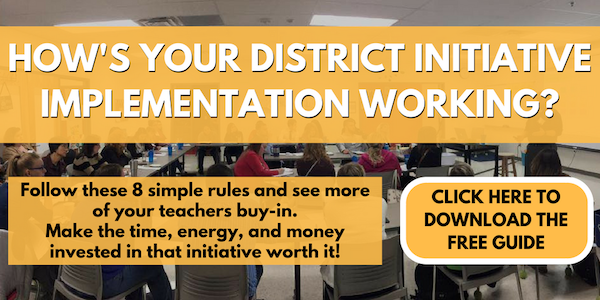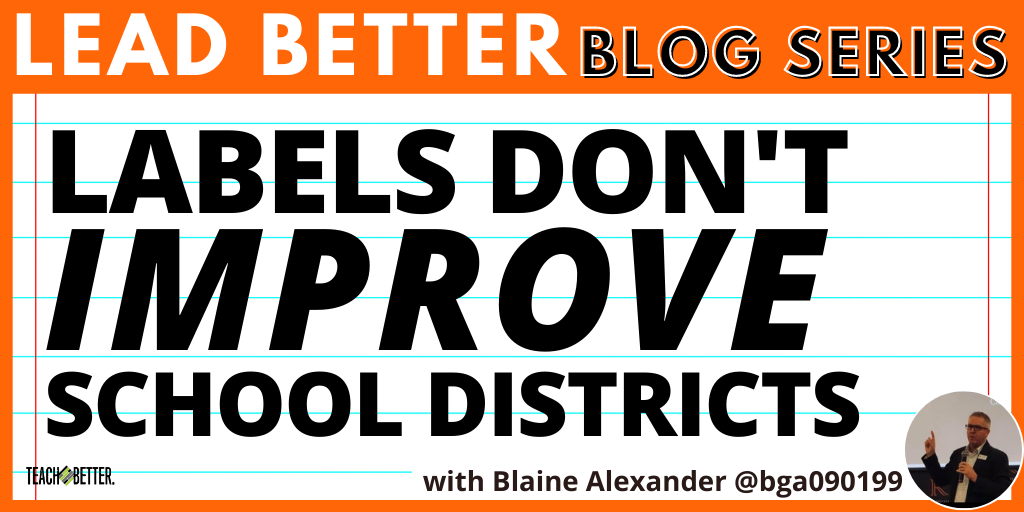TL;DR:
- Relationships and communication improve school districts.
- The conversation shouldn’t be what label to give schools; it should be how we can help and support these districts.
- We must differentiate the process for helping lower-performing schools.
Before you continue reading, I want to caution you that my blog this month is not going to make you feel like you are walking through a field of daisies with a unicorn and the sun shining on your smiling face. It is a blog to call for action. The thoughts I am sharing this month—the implications of labels put on schools—have been on my mind lately, and I am very passionate about this topic.
Although my perspective is limited to my experiences, for this blog, I have reached out to my educational colleagues across the country for input. My friends and colleagues have shared with me that this issue is prevalent in their part of the world, as well. After you read this, maybe some of you will reach out and declare that you are on board with me as a change agent and we can work together to make progress.
How We Are Perceived
The blog may be somewhat lengthy, but I beseech you to continue. A friend of mine once told me that we all get to a point in our career where others view our words in one of two ways. One, we are perceived as experienced and wise and others should listen to what we say. Or two, we are an “old coot” and don’t know what we are talking about. I am not sure if I have reached that point in my career, but I would hope that the reader will view my words from the perspective of the former description above.
If we are serious about improving schools, we must discontinue putting all districts in the same box and begin differentiating the learning cultures as needed. Click To TweetLet’s create a scenario.
You—the reader—are a classroom teacher with 25 students. Throughout the school year, you realize that the same few students in your class continually perform below standards and expectations. As you look at their student trend data, you realize that these students have performed below standards each year they have been in school. Each year, they have struggled academically. What are your next steps?
A. Continue the same process used in the past and hope for different outcomes.
B. Purchase T-shirts for these students labeled “Needs Improvement” printed on the front so everyone in the school can appropriately label the students.
C. Provide extra assignments for these students including a template for a detailed improvement plan.
D. Merge the assessment results of these students with the assessment results of a higher-performing student and use the average scores so we no longer have low scores in our class.
E. Schedule a meeting with the parents of the students and encourage them to move their child to another school district.
F. Analyze the student data, differentiate the learning process according to their needs, involve the student and parent in the process, and monitor progress – adjusting as needed.
Hopefully, all readers will agree that our actions should reflect the last option. And hopefully, you also realize that the other options should never be a choice to support the educational journey of these students. As my colleague says, “It is just common sense.”
If these actions are appropriate for student progress, the same should apply to school progress.
If this process is appropriate for students, then why don’t we use this process for schools? The next time we administer state tests to our students, I will be able to tell you what districts will be at the bottom of the achievement list. How do I know? Because the same districts have been at the bottom for years, and we have not developed effective plans and strategies to support them and improve student achievement.
I am tired of seeing the same school districts perform below standard year after year without doing everything we can to support these schools. No longer will I accept, “Well, that is just who we/they are.” This is not acceptable, and for anyone who is in this business to do what is best for kids, it should not be acceptable to you either.
We must differentiate processes for low performing schools just like we do for students.
By this time in the reading, you are saying that we do differentiate for such districts. These districts often receive extra resources, and often we send experts into their district to fix them. According to the trend data, what we have in place is not effective. When the same districts continue to show up at the bottom of the student achievement ladder, we must change strategies.
Knowing what they need begins with less mandating and more communication. We must visit these communities and have support conversations. Schools should look different if necessary. More opportunities for adult learning should be embedded into the school day. If we are serious about improving schools, we must discontinue putting all districts in the same box and begin differentiating the learning cultures as needed.
Stop putting labels or grades on school districts.
Our school districts who perform poorly know that they are performing poorly, and so does everyone else. What good does it to stick a label on the schools so the local newspaper can bash the local educational system?
Recently I was supporting a school district that has been labeled as “low performing.” A high school teacher shared the following statement with me: “Dr. Alexander, we have been beaten down for so long that we no longer see a light at the end of the tunnel, and our students deserve so much more than that.”
Allowing adults, students, and the community to live without hope and effective support is unacceptable.
In my humble opinion, this is an example of “kicking them when they are down.” If we changed our conversations from “what label do we give them” to “how can we help and support these districts,” I can assure you that progress will be made. These districts need advocates, not labels!
As leaders, we must realize that many of our struggling schools have common characteristics. And we must be brave enough to begin these conversations.
If our struggling school districts are similar in multiple ways and look alike, we are failing as leaders if we do not address this issue. This begins with building relationships and having conversations. We must stop being timid about opening up these conversations because the positive outcomes are definitely worth the effort.
Recently, I was working as leadership support in a school district in our state. The scores reflected a huge achievement gap between the two populations within the school. The adults knew that this was not an accurate representation of their student population, so guess what they did? Instead of ignoring it (which was definitely the safe route), the adults began to have conversations with the students who represented the lower scores. In small groups, the adults shared the data and asked the students, “How are we not successfully meeting your academic needs, and what can we, as adults, do better?”
The adults held themselves accountable for the low achievement scores.
Should I say that again for those in the back?
They understood that adult behaviors must change for student achievement to improve. The adults did not blame the students. Wow, the mind is blown! Oh, by the way, the achievement gap closed by 18% over the next year because they started having conversations with the struggling students.
As state leaders, we must be accountable for our struggling school districts. Are we finding opportunities to have these conversations with the leaders, teachers, parents, and community leaders in our struggling school districts? If our struggling school districts have similarities, it is up to us to begin conversations about solutions.
There are faces behind data and test scores do not define the heart, resilience, and dedication of our young people.
It is very easy to look at school district data and make improper judgments about the current reality. With my occupation, I have the opportunity and privilege to work closely with some school districts that have been labeled ineffective because of summative test scores. With their permission, I would like to introduce you to some “test scores” from some “low performing schools” who have made a huge impression on me.
Meet Jaden, who gets up extra early to get to school to reduce the chances he runs into local gang members. He knows that, if he succumbs to their recruitment, his education will suffer.
Next, meet Shandra, who is a 16-year-old single mother with no parental support who raises her child alone and finds daily daycare to stay in school herself. She shared with me that her education is going to help her support her daughter.
Then there is Shamar, who is the oldest sibling of seven children and is responsible for making dinner, putting to bed, waking, and feeding his younger siblings every day so his mother can work two jobs to support them. As of this writing, they have not missed the bus all year.
These are just a few examples of the faces I see every week. We must stop seeing these young people as a test score and stop labeling them as unsuccessful. Due to life situations, it may be difficult to perform well on mandated assessments during one week of the school year.
These young people have taught me so much about resilience and commitment because all of them had every opportunity to give up on their education, but they have not. A test score does not define these students!
Do not judge the dedication and work ethic of administrators, teachers, or students by summative assessments.
Some of the most committed and hard-working teachers I have ever met are in schools that are considered “low performing” due to summative state assessments. No longer should we assume that our “best” teachers are in our high performing schools and our least effective teachers are in our lowest-performing schools.
Quite honestly, there are too many variables to ever make this assumption.
A friend of mine spent nine years teaching in a “low performing school” and she mentioned to me that the message communicated to the teachers was “you must do better.” She was a hard-working and dedicated teacher who would do anything in the world for her students. Her husband was transferred to an area where the schools performed at a higher level on state assessments, and all of a sudden, she became a very strong teacher. Her teaching strategies did not change but, in both places, her value was determined by student achievement scores.
Resources must be allocated where there is the most need.
As a patient in the hospital in critical condition, I would want the most effective doctor in the hospital caring for me. I want this doctor to spend as much time as possible to bring me back to health, and not stop in the middle of surgery because the timer went off because there is some arbitrary time in which I should have become healthy.
Education friends, shouldn’t we have the same commitment to education as doctors have in saving lives? Why do we send our most ineffective teachers to the schools in most need? Why do our “best” teachers get assigned to the big, new, fancy school in a certain part of town? When we know this is not a best practice, why do we continue to put a time limit on learning?
It is time we assign our most effective teachers to those schools in triage. It is time we stop allocating money equally and start allocating more money to those schools that need more resources. But don’t stop there. We must support the leaders on how to effectively utilize those resources for school improvement.
Why do we continue to put a time limit on learning? The objective is to learn, not learn this skill “in this amount of time.” Again, it just makes sense!
[scroll down to keep reading]
Mottos and hashtags alone do not improve schools.
This will be short and sweet. As educators, we are so good at creating mottos, hashtags, and themes for the year. Here are some examples I have seen just in the last week.
- We provide a world-class education to all students.
- Student Focused Learning
- Whatever It Takes; Every Child Every Day
- All Students Matter
Everyone reading this blog can add many more mottos or themes. These are great visions, but unless our behaviors reflect these mottos, they are worth less than the acrylic sign on which they are placed on the front lawn of the school. Quotes on our website do not produce change.
I may have touched some nerves with this blog, but maybe nerve touching is exactly what we need to kick-start change. If we are serious about providing opportunities to all students, it is time we stop labeling our schools and start doing whatever it takes to support them. If all means all, let’s live it. Jaden, Shandra, Shamar, and every other student who has been labeled deserve it!
About Blaine Alexander
Dr. Alexander is currently serving his eleventh year as a Leadership Performance Coach with the Arkansas Leadership Academy through the University of Arkansas. Prior to his current experience in leadership development, Dr. Alexander served as a school administrator for 17 years. His research focuses on developing collaborative cultures founded on trust and respect and immersed in student and adult learning. Dr. Alexander’s dissertation explores the factors necessary for student voice to be institutionalized and taken to scale in a school district. Each year, he facilitates learning for students and teachers in the Arkansas Leadership Academy’s Student Voice Institute.
Education:
B.A. Harding University, Searcy, Arkansas
M.Ed. Harding University, Searcy, Arkansas
Ed.D. University of Arkansas, Fayetteville, Arkansas
Dissertation: Student Voice Initiative: Exploring Implementation Strategies



